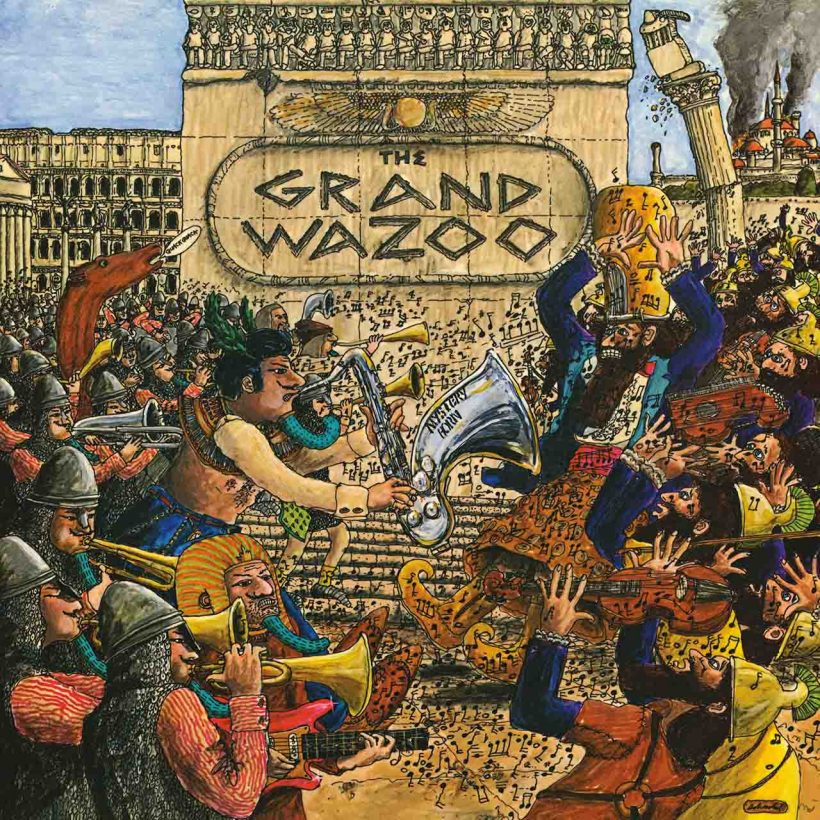‘The Grand Wazoo’: How Frank Zappa Made A Jazz Fusion Classic
From thrilling jazz-rock workouts to balmy beauty, this album has it all… and it was recorded just months after Frank Zappa suffered life-threatening injuries.

If you’ve ever wondered why Frank Zappa is regarded as a musical genius, you’ll find the proof in every groove of The Grand Wazoo – it’s an album alive with ideas, ambition, and humor that skips between genres with abandon, from exhilarating jazz funk to wee small hours jazzy shuffles. If the words “jazz fusion” cause concern, The Grand Wazoo is an accessible entry point. If you’re already a fan of the Zappa of Hot Rats or We’re Only In It For The Money, prepare to have your mind blown all over again.
The album was recorded in 1972, a fantastic year for Frank Zappa musically. In April and May, he recorded two albums of ambitious, sophisticated, and witty jazz fusion – Waka/Jawaka (released July that year) and The Grand Wazoo, which hit shelves in November. The music itself is proof of Frank Zappa’s incredible creativity, but what makes his output that year truly remarkable is that he managed to write and record anything at all.
Order the expanded versions of Waka/Jawaka and The Grand Wazoo here.
On December 10, 1971, Zappa was attacked by a member of the audience while playing with The Mothers Of Invention at The Rainbow Theatre, London. The assailant, 24-year-old Trevor Howell, later claimed that his girlfriend was besotted with Zappa and, in a fit of rage, sought his revenge. Howell launched himself at an off-guard Zappa who was pushed off the stage in the ensuing melee. Zappa recalled the severity of his injuries in his 1989 autobiography, The Real Frank Zappa Book, “The band thought I was dead… My head was over on my shoulder, and my neck was bent like it was broken. I had a gash in my chin, a hole in the back of my head, a broken rib, and a fractured leg. One arm was paralyzed.” Zappa also suffered a crushed larynx, which would have a lasting effect on his vocals – his range fell, and he became more reliant on the vocal contributions of his bandmates.
Zappa was confined to a wheelchair for most of the following year and suffered from chronic back pain as a result of the accident. Most mortals would’ve enjoyed an extended period of convalescence. Not Zappa. By April, he’d composed enough material to enter Paramount Studios, Hollywood, Los Angeles, to record Waka/Jawaka and The Grand Wazoo.
Though it was the second of the pair to be released, in no way is The Grand Wazoo a collection of outtakes or off-cuts – it’s a fully-formed album with a strong identity. Waka/Jawaka swims in similar jazz fusion waters, but it uses a small jazz combo, The Grand Wazoo saw Zappa embracing a big band with a clarity of purpose.
The title track opens the album in epic fashion, its regal groove stretching out over 13 minutes in which barely a second is wasted – Zappa and Tony Duran trade sparky, seat-of-your-pants guitar solos and Sal Marquez thrills with a meandering trumpet solo, while the track shifts through several distinct sections, steered by the intuitive drumming of Aynsley Dunbar. “For Calvin (And His Next Two Hitch-Hikers)” is an ominous jazz waltz, the only song here with actual lyrics – a set of unsettling questions delivered deadpan, adding to the general sense of unease.
“Cletus Awreetus-Awrightus” is the sort of frenetic and zany feat of imagination that only Zappa could pull off – a rollicking jazz rock tune with wild horn and guitar parts echoed by comic vocal riffing by Zappa, Chunky, and George Duke. “Eat That Question” begins with Zappa establishing a bluesy guitar riff before George Duke’s inspired, fluid keyboard playing takes the track to a whole new cosmic level. The album’s final cut, “Blessed Relief,” shows that Zappa was capable of creating moments of bittersweet beauty.
Considering the circumstances that led to The Grand Wazoo’s creation, it would have been understandable had Frank Zappa wallowed and produced music steeped in self-pity. That wasn’t Zappa’s style, instead he made some of his most life-affirming and accessible music. “Grand” was an understatement.
Order the expanded versions of Waka/Jawaka and The Grand Wazoo here.













Jeffrey Fox
November 30, 2023 at 5:11 pm
Actually, the album starts with “For Calvin” and the title track follows. In terms of the conceptual continuity, that works better. I think they flipped the order decades later, but that doesn’t work as well. Why? Well because “Calvin” leads into the title rtrack, by virtue of the great trombone solo in “Calvin” and the further solo in the title track. Remember, this was vinyl. But it is a glaring error on the cd, because the first track on side 2 also followed logically from the final notes of the title track, and leading into that from “Calvin” is ridiculous. “The Grand Wazoo” was a great album, perhaps as great as “Hot Rats”a, and the best he ever put out.So why was “The Grand Wazoo” such a commercial failure? It’s simple! Jazz isn’t as popular as rock ‘n roll, voilà.